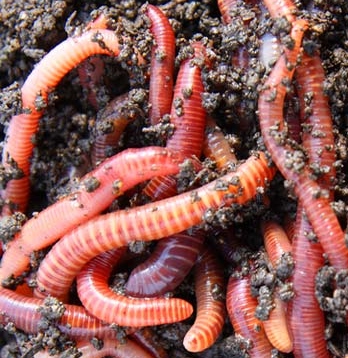Active red wigglers: Recycle waste effectively
Active red wigglers: Recycle waste effectively
Blog Article
Whatever You Required to Understand About Red Wigglers for Composting
Red wigglers, or Eisenia fetida, play a critical role in the realm of composting, changing natural waste into valuable soil changes. The procedure of establishing up a worm container and preserving it can pose obstacles.
What Are Red Wigglers?

(Charlotte Worm Farms)
Belonging To North America, red wigglers are surface-dwelling organisms that favor moist, warm environments abundant in disintegrating raw material. Their diet consists mainly of decomposing plant product, food scraps, and other organic debris, which they consume and damage down efficiently. As they absorb this product, they create nutrient-rich castings that improve dirt fertility.
Red wigglers are hermaphroditic, having both male and women reproductive organs, and can duplicate rapidly under ideal problems. Overall, red wigglers are crucial factors to the process of recycling natural waste right into valuable compost.
Advantages of Using Red Wigglers
Utilizing red wigglers in composting systems supplies numerous advantages that improve both the performance of waste management and the quality of the resulting compost. These worms, scientifically recognized as Eisenia fetida, are specifically reliable at breaking down organic matter, turning kitchen area scraps and yard waste right into nutrient-rich compost at a sped up price.
Among the key advantages of making use of red wigglers is their ability to consume large amounts of organic material, commonly refining their weight in food waste daily. This high usage price results in quicker decay and minimizes the quantity of waste sent to garbage dumps. Moreover, the castings generated by red wigglers are rich in crucial nutrients, helpful bacteria, and enzymes, making them a superb plant food for gardens and plants.
Additionally, red wigglers grow in a selection of atmospheres, making them adaptable for both indoor and outside composting systems - red wigglers. Their visibility in a garden compost bin assists to freshen the product, preventing odors and advertising a healthy and balanced composting process. Overall, using red wigglers not just contributes to reliable waste monitoring yet likewise sustains lasting horticulture methods through the manufacturing of premium garden compost
(purchase red worms)
Setting Up Your Worm Bin
To effectively establish a worm container, it is vital to choose a suitable container that satisfies the requirements of red wigglers while supplying a conducive atmosphere for composting. An appropriate container can be made from plastic, timber, or steel, with a capability of at the very least 1 square foot for every single extra pound of worms.
Make certain the container has adequate drainage holes to stop excess moisture, as red wigglers thrive in a damp, but not waterlogged, environment. red wigglers. The bin should also be ventilated to provide sufficient air movement, protecting against anaerobic problems that can damage the worms
A suitable place for the worm bin is an awesome, dark area, without straight sunshine and severe temperatures, as red wigglers choose a temperature variety of 55 to 77 levels Fahrenheit.
Prior to introducing the worms, prepare bedding products such as shredded paper, cardboard, or coconut coir, which will give both environment and food. Moisten the bedding gently to produce a welcoming environment for the worms. Take into consideration putting a cover on the container to maintain humidity and reduce pests, while guaranteeing it can be conveniently eliminated for maintenance.
Feeding and Care Standards
Feeding red wigglers is a crucial element of preserving a healthy and balanced composting system. These worms prosper on a varied diet regimen, largely composed of organic products such as vegetables and fruit scraps, coffee grounds, and crushed eggshells. It is necessary to prevent feeding them meat, milk, and oily foods, as these can produce undesirable odors and bring in insects.
When presenting food to your worm bin, chop or shred materials right into smaller sized pieces to promote quicker decay. Start with percentages to assess the worms' intake rate, progressively increasing the amount as they adjust. It is recommended to alternative feeding locations within the bin to urge detailed blending and oygenation of the compost.

Troubleshooting Common Issues
Keeping a flourishing worm composting system can often offer challenges that need attention and troubleshooting. Typical concerns consist of an undesirable odor, which often browse around here shows overfeeding or the visibility of anaerobic conditions. To remedy this, lower the amount of food added and make certain correct aeration by blending the bed linens product.
Another constant issue is the getaway of worms from the bin. This can take place as a result of extreme wetness or inappropriate ecological problems. Routinely examine the wetness levels, going for a damp yet not soggy uniformity, and maintain optimum temperatures in between 60-80 ° F(15-27 ° C )to produce a comfy environment for your red wigglers.
Insects, such as fruit flies, can also invade worm bins. red wigglers. To fight this, cover food scraps with a layer of bed linens or shredded paper to deter flies from laying eggs. Additionally, ensure that any kind of food included is fresh and totally free from mold and mildew, which can attract undesirable pests
Lastly, if your worms seem non-active, look for stress and anxiety factors such as temperature level variations or poor dampness. Dealing with these typical problems will certainly assist preserve a healthy and productive worm composting system.
Final Thought
In summary, red wigglers, or Eisenia fetida, play a crucial duty in sustainable waste monitoring via vermicomposting. Their ability to effectively transform natural waste into nutrient-dense castings boosts dirt health and promotes plant growth. Correct arrangement and maintenance of a worm container, in addition to adherence to feeding guidelines, guarantee a successful community that reduces landfill payments. Resolving usual concerns immediately better sustains the efficiency of this ecological method, adding to environmental sustainability and farming productivity.
Report this page